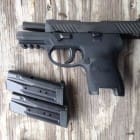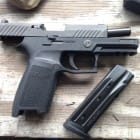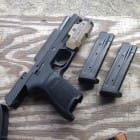
SIG Sauer was displaying some of their latest firearms, including the P320 striker fired pistol series, the MPX machine pistol, and the MCX carbine, which were available to shoot, which we did.

The MPX was the 9mm SBR variant with the telescoping stock, 8″ barrel, and SIG’s proprietary aluminum handguard. The controls are similar to an AR-15, although it utilizes a short stroke push-rod gas system. The familiarity of the controls makes it easy to adapt to, and it’s an accurate weapon with very little recoil.

The MCX was chambered for .300 BLK and was outfitted with the 9″ barrel and SIG SRD762 silencer, which made it a very quiet gun; with that can, earpro wasn’t really required. The handguard features KeyMod attachment slots, for the attachment of accessories such as a grip or light. Like the MCX, the MCX has AR-15-style controls, and a short stroke gas piston system.

It’s accurate, with very little noticeable recoil. Frankly, it’s a joy to shoot.
The P320 series consists of several sizes of polymer frame, striker fired pistols. All the models at the range day were chambered for 9mm, although chamberings for 357 SIG, .40 S&W, .45ACP are also available, depending on the model. The Sub-Compact model comes with double-stack magazines with a capacity of 12 rounds. The Carry and Medium Full are capable of holding 17 rounds, and the compact can carry 15. They come standard with SIGLITE Night Sights, and the grips are interchangeable.
The Carry was the most comfortable to shoot, although even the Sub-Compact was comfortable despite the smaller frame. The sights were quick to pick up, and the trigger was crisp on each model.

This clear HTC holster was placed among the SIG table; it’s always cool to see non-production demonstration models on display like this.
www.sigsauer.com




























































































































